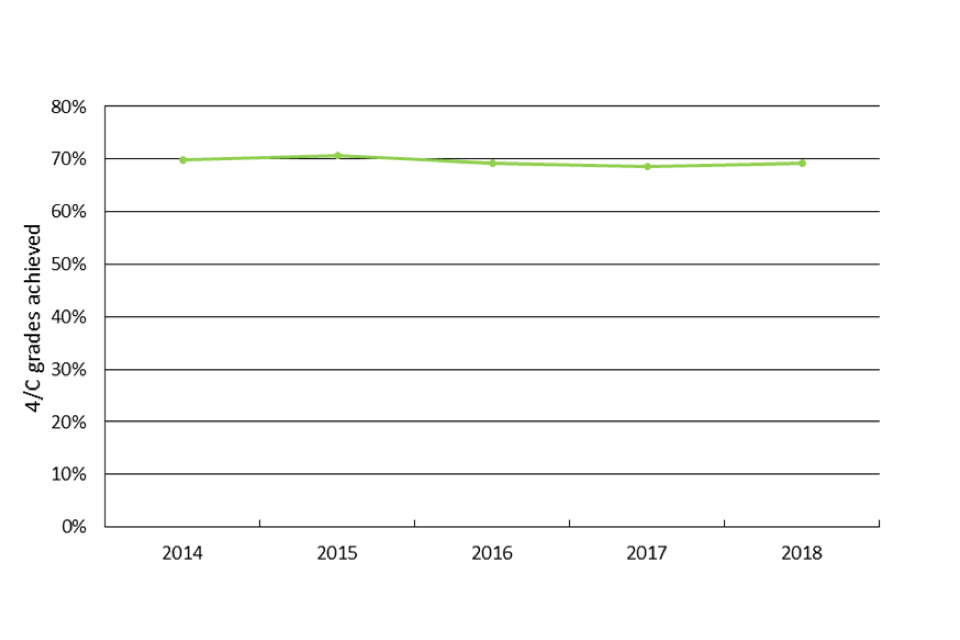Ofqual’s Guide to England’s #GCSEresultsday2018

Ofqual’s guide to results, standards and grade boundaries in the 2018 GCSE results in England.
Key points
- Overall GCSE outcomes have remained stable in recent years and this trend continues this year.
- Overall results for 16-year-olds in English language and mathematics are stable at grade 4 compared to last summer.
- The variability in results within centres is similar to previous years suggesting that schools and colleges have responded well to the reforms. Even when there are no changes to qualifications, individual schools and colleges will see variation in their year-on-year results; this is normal.
Today (23 August 2018) we are publishing:
- a summary of this year’s results (below)
- an infographic about this year’s GCSE results
- a report on variability in GCSE results for schools and colleges, 2016 to 2018
- a summary of our monitoring of this year’s GCSE, AS and A level exams
- interactive analytics of this year’s GCSE results
Background to GCSE reforms
This summer is the second year that reformed GCSEs graded 9 to 1 have been awarded. Reformed qualifications in 20 subjects were awarded for the first time this summer, in addition to the 3 reformed subjects that were awarded for the first time in 2017. Changes to the GCSEs reflect the government’s intention that the qualifications better prepare students for further study and work, are more stretching for the most able students, and remain accessible to the range of students who have traditionally taken GCSEs.
The new GCSEs are being phased in. This year about 90% of GCSE entries in England were for reformed GCSEs. By 2020 all GCSEs taken in England will be in line with this policy and will be graded 9 to 1.
Setting standards in GCSEs in 2018
We have explained our approach to setting standards in GCSEs this summer in our monitoring report. In the 2018 awards, exam boards used predictions based on students’ prior attainment at key stage 2 to guide the setting of grade boundaries. And, as in previous years, senior examiners have been involved in all awards. In the reformed GCSEs they were asked to check whether student work at the grade boundaries suggested by the statistics was at an acceptable standard for the grade (at grades 7, 4 and 1).
Overall GCSE outcomes
Overall, GCSE outcomes have remained stable in recent years, with only small changes in the cumulative percentage outcomes at grade 4/C and above. This is illustrated in the chart below, that shows the overall GCSE outcomes for 16-year-olds in England at grade 4/C and above between 2014 and 2018.
Overall GCSE outcomes for 16-year-olds in England at grade 4/C and above, 2014-2018

GCSE English language, English literature and mathematics
This is the second summer that reformed 9 to 1 GCSEs in English language, English literature and mathematics were awarded. Last summer post-16 students who were re-sitting English language and mathematics could either enter the reformed 9 to 1 qualifications or the legacy A* to G qualifications (there was no legacy resit opportunity in English literature). Because of this, the overall results (for all students) for the reformed 9 to 1 qualifications in English language and mathematics are lower in 2018 compared to last summer, because the cohort has changed. When only 16-year-olds are considered, the outcomes in the reformed 9 to 1 qualifications are broadly stable at grades 9, 7 and 4 compared to last summer. Where there are small changes in outcomes, these are due to changes in the ability of the cohort.
16-year-olds outcomes in GCSE 9 to 1 English language and mathematics
| Subject and year | Cumulative % at grade 9 |
Cumulative % at grade 7 |
Cumulative % at grade 4 |
|---|---|---|---|
| English language, 2017 | 2.6 | 16.8 | 69.9 |
| English language, 2018 | 2.6 | 17.5 | 70.2 |
| Mathematics, 2017 | 3.5 | 19.9 | 70.7 |
| Mathematics, 2018 | 3.6 | 20.0 | 71.0 |
GCSE combined science
This summer reformed 9 to 1 GCSEs in the sciences were awarded for the first time. There is a new GCSE in combined science that replaces the legacy GCSEs in science and additional science. Combined science is worth 2 GCSEs and so students will get a double grade, from 9-9, 9-8, 8-8 through to 1-1. There are also reformed 9 to 1 GCSEs available in the three separate sciences – biology, chemistry, and physics. Some students therefore enter combined science, and other students enter the separate sciences. The proportion of students achieving grade 4 and above in the separate sciences is higher than the proportion achieving grades 4-4 and above in combined science, reflecting the different ability profiles of students taking separate sciences and combined science.
The move to a double GCSE in combined science from the legacy GCSE science and GCSE additional science makes year-on-year comparisons more challenging. In previous years some students taking GCSE science and GCSE additional science took both at the end of year 11, but a sizeable number of students instead took GCSE science in year 10 and GCSE additional science in year 11. For combined science we have therefore compared the outcomes at grades 7-7 or 4-4 and above, with the outcomes in science and additional science at grades A or C and above in 2017. In doing so, we have taken account of the different routes that students previously took through science and additional science. Our 2017 figures therefore include the outcomes for 16-year-olds in science and additional science in 2017, and the outcomes for students aged 15 and under in science in 2016. This shows that overall outcomes in combined science are similar to the outcomes in the legacy GCSE science and GCSE additional science at grades 7-7/A and 4-4/C.
16-year-olds outcomes in GCSE 9 to 1 combined science compared to science and additional science
| Subject and year | Cumulative % at grade 7-7 or A |
Cumulative % at grade 4-4 or C |
|---|---|---|
| Science and additional science (legacy) 2016* and 2017 | 7.6 | 55.2 |
| Combined science (reformed) 2018 | 7.3 | 54.7 |
* 15-year-olds and under only in 2016.
Grade 9 in reformed GCSE subjects
This is the second summer that grade 9 is awarded in reformed GCSE English language, English literature and mathematics, and the first award of grade 9 in 20 more subjects. Grade 9 is not the same as A*: it is a new grade, designed to recognise the very highest performing students, so there are fewer grade 9s than there were A*s. The new grade 8 straddles the top of the old A and the bottom of the old A*, so there is no direct comparison with A*. We have previously outlined the details of how grade 9 (or grade 9-9 in combined science) works.
This summer reformed 9 to 1 GCSE specifications were awarded in 23 subjects. On average, 16 year-old students in England took 7.46 reformed 9 to 1 GCSEs, so we have looked at the number of students taking at least 7 reformed 9 to 1 GCSEs who achieved a grade 9 in all of their 9 to 1 graded subjects. In total, there were 732 students that achieved this, 62% of whom were female and 38% of whom were male.
Grade boundaries
It is difficult to compare in a meaningful way grade boundaries between reformed and legacy qualifications, for several reasons. Maximum marks for the papers differ, the number of papers in a subject differs, and the type of assessment can be different. It is particularly difficult to compare reformed grade boundaries with those for the legacy qualifications for which there was a significant amount of non-exam assessment, or where the proportion of non-exam assessment has changed, since the grade boundaries on written papers may have been higher to compensate for relatively high performance on the coursework. This means it is difficult to make comparisons for the majority of reformed GCSEs awarded for the first time this summer, since most contain some non-exam assessment.
We have therefore only compared grade boundaries with last summer for reformed GCSE qualifications first awarded in summer 2017, since for these qualifications we are able to compare like-with-like.The following table shows a summary of the changes in subject level grade boundaries for these qualifications compared to summer 2017. Although exam papers are intended to be of the same demand as previous years, in practice, this is very difficult precisely to achieve, so grade boundaries change to take account of the demand of the papers.
Overall, the grade boundaries have increased slightly compared to last summer. On average, the boundaries have increased by 1.9 raw marks (or 0.6% of the maximum mark) at grade 7, and by 4.6 raw marks (or 1.8% of the maximum mark) at grade 4.
Changes in paper grade boundaries for reformed GCSEs first awarded in 2017
| Grade | Average raw mark change |
Average mark change (% of max mark) |
|---|---|---|
| Grade 7 | 1.9 | 0.6% |
| Grade 4 | 4.6 | 1.8% |
Post-16 outcomes in English language and mathematics
There has been an increase in post-16 entries for GCSE English language this summer (from 135,881 to 148,894), and a decrease in post-16 entries for GCSE mathematics (from 167,541 to 160,519). The table below shows the cumulative percentage outcomes for 17-year-olds, 18-year-olds, and students aged 19+ for English language and mathematics this summer compared to 2017 (these figures are based on data supplied to Ofqual by the exam boards on or before 15 August – while the data is not quite complete, any missing data is likely to be missing at random).
In 2017, some post-16 students sat the reformed GCSE 9 to 1 qualifications, and others sat the legacy GCSE A* to G qualifications. We have combined the data from these qualifications at grades 7/A and 4/C for 2017, and compared this to the outcomes at grades 7 and 4 this summer (when only reformed qualifications are available).
Post-16 outcomes in English language and mathematics
| Subject | Age | 7 or A and above, 2017 |
7 or A and above, 2018 |
4 or C and above, 2017 |
4 or C and above, 2018 |
|---|---|---|---|---|---|
| English language | 17-year-olds | 1.1 | 1.2 | 29.1 | 32.0 |
| English language | 18-year-olds | 0.3 | 0.5 | 24.6 | 27.7 |
| English language | 19+ | 2.7 | 2.7 | 39.4 | 39.8 |
| Mathematics | 17-year-olds | 1.5 | 1.5 | 24.6 | 22.3 |
| Mathematics | 18-year-olds | 0.4 | 0.3 | 16.5 | 14.3 |
| Mathematics | 19+ | 2.4 | 1.8 | 33.9 | 29.7 |
Published 23 August 2018
Topics
Guidance and regulation
- Appeal an exam result
- Guide
- Performance points: comparing KS4 or 16-to-18 qualifications
- Guidance
- Infographic: GCSE results 2017
- Guidance
News and communications
-

News story – 20 April 2018
-

News story – 19 April 2018
-

News story – 29 March 2018











Responses